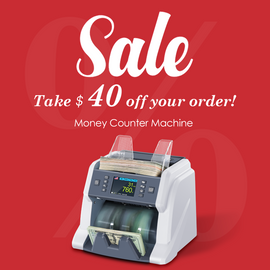Counterfeit money is a growing problem in today’s economy. Because of the advanced technology available to counterfeiters, it is becoming increasingly difficult to tell the difference between genuine and fake currency. In an effort to combat this issue, many businesses have turned to counterfeit pens as a way to detect counterfeit bills. But in reality, counterfeit pens are not reliable at all when it comes to detecting counterfeits money.
How do counterfeit pens work?
Counterfeit pens are a common tool used by businesses to detect fake bills. These pens contain a special ink that reacts with the paper found in legitimate currency. When the pen is used on a counterfeit bill, it will leave a noticeable mark that shows the bill is not genuine.
The process works by having the user draw the pen across the surface of the bill. If the bill is real, the mark left by the pen should be faint or invisible. However, if the bill is fake, the pen will leave a dark, distinct mark. This mark indicates that the bill is not authentic, and can be easily spotted by employees or customers.
Additionally, many counterfeit pens have multiple colors of ink so that they can be used on different types of bills. For example, some pens may have red and blue ink, which can be used to test US dollars, Euros, and other types of currency.
Why counterfeit pens are not reliable?
First, it is actually quite easy for counterfeiters to replicate the security features found in genuine currency, which means that even if the pen changes color when a counterfeit bill is marked, it does not necessarily mean that the bill is real.
Another issue with counterfeit pens is that many of them are not sensitive enough to detect subtle variations in the chemicals used in genuine currencies. For example, some countries use different concentrations of the same chemical in their bills, so a counterfeit pen may be unable to detect these minor differences. This could result in a false positive, which could lead to a business accepting a counterfeit bill without realizing it.
In addition, counterfeit pens are not 100% accurate. Even if the pen reacts to a bill, there is no guarantee that the bill is genuine. It is possible that the pen may react to other substances found on the bill, such as residue from a person’s hands or sweat on the bill. This could lead to a false positive and could result in the business accepting a counterfeit bill.
Finally, counterfeit pens are not cost effective. These pens are often quite expensive, so it can be difficult for small businesses to afford them. Furthermore, even if the pens do detect a counterfeit bill, it is up to the business to decide what to do with it. This means that the business is still at risk of losing money if they accept a counterfeit bill, regardless of whether the pen detected it or not.
The Best Way to Detect Counterfeit Bills
The best way to detect counterfeit bills is to use a combination of methods. It is important to be aware of the various ways in which counterfeiters create fake money and to use multiple techniques to identify them.
Manual Inspection
One of the most effective methods for detecting counterfeit bills is to closely manually examine the bill itself. Genuine currency has certain security features that are difficult to replicate, such as raised lettering, special printing effects, watermarks, and holograms. Examining the bill closely can reveal inconsistencies in these features, making it easier to spot a fake. Additionally, it is important to check for signs of wear and tear, as counterfeit bills often have a more uniform look than genuine currency.
Technological Solutions
Another way to detect counterfeit bills is to use a banknote counter machine with counterfeit detection. These machines use ultraviolet and magnetic sensors to detect fake money by checking for discrepancies in the paper, ink, and other materials used to print the bill. This method can quickly and accurately detect counterfeit bills without the need for manual examination.
Employee Training
Businesses should also train their employees to recognize the signs of counterfeit bills. This includes teaching them how to identify differences in the paper, ink, and design of the bill, as well as any irregularities or anomalies that may indicate a counterfeit.
Combination of Methods
Ultimately, the best way to detect counterfeit bills is to use a combination of methods. Businesses should train their employees to recognize the signs of counterfeiting and employ a counterfeit detection machine to help them quickly and accurately identify fake bills. By using a combination of methods, businesses can protect themselves from fraud and ensure they are only accepting genuine currency.
Conclusion
While counterfeit pens are a common tool in detecting fake bills, their limitations and the advancement in counterfeiting techniques significantly reduce their reliability. A multi-faceted approach combining technology, manual inspection, and informed staff is a more effective strategy to identify counterfeit currency.







